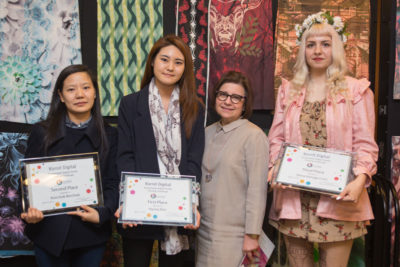For the second year in a row, Kornit Digital, a company that develops and manufactures eco-friendly textile printing technology, sponsored a design challenge for fourth-year Textile/Surface Design students, judged by top industry designers. The results showed off both the creativity of the students and the quality of Kornit’s Allegro textile printing system, a nontoxic, one-step process with no minimum yardage requirements.
“The textile industry is one of the top polluting industries in the world,” Paul Borucki, managing director of Kornit Digital North America, said. “Our process emits no VOCs, and no waste products go into the soil.”

Each student submitted a sustainability-themed design, an explanation of the concept, and an image of how the design could be applied to a garment. In preparation for the judging, Kornit produced ten yards of each design using the Allegro system.
The judges were Tom Cody, principal of Tom Cody Design; Joe Castaldo, Textile and Apparel Marketing ’73, president of the Style Council; Melissa Niederman, Fashion Buying and Merchandising ’88, art director of the Style Council; Leslie Baker, associate designer for the Bon-Ton Stores’ Relativity brand; and Vanessa DeSousa, Textile/Surface Design ’10, development manager of print and embellishment for Diane von Furstenberg. Representatives from Kornit also weighed in. Judging was based on five factors including the concept, the effectiveness and marketability of the design, and the conceptualized fashion application.
The winners were announced at an event on April 23. Hyuna Kim ’15 won first prize of $3,000, Konchock Bercholz ’15 took second place and $2,000, and the $1,000 third prize went to Elena Kanagy-Loux ’15. Kornit had planned to produce a garment from only the first-place design, but Erin Doty, the company’s North American art director and project manager, announced that all three would be fabricated.
Tom Cody said all the winning designs were elegant and commercial and could easily be translated into clothes. He admired Kim’s restraint in her use of color, saw Bercholz’s design as ideal for swimwear, and loved Kanagy-Loux’s concept—a skeleton made of flowers.
Cody also called Kim’s first-place design “fashion-ready,” adding, “I could put it in my collection and it would sell right away.”
